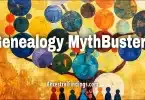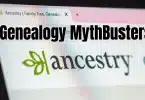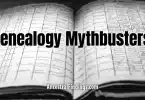Have you ever heard a family story that sounds just a little too good to be true? Maybe it’s the tale of a “Cherokee princess” somewhere in your tree. Or maybe a great-aunt swore that your family is connected to European royalty. These are two of the most popular legends in genealogy, and they’ve been told so many times that they start to feel like fact.
Here’s the truth: Native tribes didn’t have “princesses,” and most family lines don’t secretly lead back to kings and queens. Still, these stories stick around because they’re exciting, a little glamorous, and they give us a sense of pride.
That doesn’t mean your family history isn’t fascinating—it just means the real story might be very different than the legend. And honestly, that’s where the fun begins. In this article, we’ll look at where these myths came from, why they’ve lasted so long, and how you can check the facts for yourself.
The Cherokee Princess Myth
Where the Idea Came From
The Cherokee princess tale is everywhere. Ask around, and you’ll find dozens of families who claim one. But there’s one big problem: Native tribes didn’t have kings and queens—so no princesses either.
The “princess” title comes from European storytelling. Outsiders often misunderstood Native leadership systems and tried to fit them into European molds. A chief’s daughter wasn’t a princess; she was simply part of a respected family.
Why Families Kept Telling the Story
- Romantic storytelling: In the 1800s, Americans loved to romanticize the frontier and Native life. Turning a Native ancestor into a “princess” added drama.
- Oral tradition drift: A vague memory—“we had Cherokee ancestors”—grew bigger with each retelling, eventually becoming “a princess.”
- Social appeal: At different times, claiming Native ancestry gave families a unique identity and an exotic twist to their history.
A Real-Life Example
The Smith family of Kentucky passed down a tale that their great-great-grandmother was a Cherokee princess. But research showed she was born to German immigrants with no Native ancestry. The story had grown from a neighbor’s connection with local tribes. Over generations, it became “fact.”
The Royal Ancestor Legend
The Dream of Blue Blood
Equally popular is the claim that your family descends from European nobility. Maybe it’s a duke, an earl, or even a king or queen. There are genuine cases of royal descent, but they’re much rarer than family legends suggest.
Why This Story Persists
- It feels prestigious: Linking a family to nobility makes the story feel important.
- Embellished genealogies: In the 19th century, some “family historians” exaggerated royal links to sell books.
- Mistaken identity: A wealthy farmer or mayor could be remembered as “noble” generations later.
A Real-Life Example
The Johnson family of Ohio believed they came from French royalty. Their surname matched a noble French line, but records showed their ancestor was a farmer in Alsace. The leap from surname to nobility was a mistake—but the myth endured because it sounded grand.
How Popular Culture Kept the Myths Alive
These legends didn’t just come from families—they were fed by popular culture.
- Dime novels and Wild West shows in the 1800s turned Native women into “princesses” to entertain crowds.
- Victorian genealogy books exaggerated royal ties to attract readers.
- Hollywood films carried both myths forward, cementing them in American imagination.
By the time these stories reached your grandmother’s kitchen table, they were already deeply rooted in culture.
What the Records Actually Show
When you dig into records, the stories often unravel:
- Instead of a Cherokee princess, you might find a woman who lived near Native tribes or married into a Native family.
- Instead of a king, you might find a hardworking shoemaker or farmer with the same surname as nobility.
But far from being a letdown, this can be more meaningful. These ancestors survived wars, migration, and hardship. They built lives out of sweat and sacrifice—not crowns and titles—and their stories are every bit as worth telling.
How to Check These Family Legends
1. DNA Testing
- Native ancestry: Autosomal DNA may reveal Native heritage within the last 5–7 generations. But beware—tiny percentages may come from population overlap, not direct descent.
- Royal ancestry: DNA won’t usually help. Documented lineages are more reliable for tracing royal lines.
2. Tribal Records
For Cherokee ancestry, the Dawes Rolls (1898–1914) are essential. If your ancestor isn’t listed, proving tribal enrollment is difficult. Each tribe has its own criteria for recognition.
3. Vital and Church Records
Marriage, baptism, and burial records can reveal ethnic origins. Sometimes a simple parish entry clears up a centuries-old myth.
4. Published Genealogies
Noble and royal families are well documented in works like Burke’s Peerage. If your family’s claimed ancestor isn’t listed in credible sources, the connection is probably wishful thinking.
Why These Myths Stick Around
So why do these legends have such staying power? Because they’re about more than fact—they’re about identity.
- A Cherokee princess in your tree makes your family sound unique.
- A king or queen as an ancestor makes you feel part of something grand.
The problem is, these myths often overshadow the real stories waiting to be discovered.
Why Ordinary Ancestors Are Extraordinary
Crowns and titles don’t make an ancestor more important. What matters are the lives they lived and the struggles they overcame.
Your ancestors farmed, built homes, crossed oceans, raised children, fought in wars, and survived illnesses. They may not have ruled a kingdom, but they left behind something far more lasting: the resilience that carried your family forward.
The Real Story
The Cherokee princess and royal ancestor myths are entertaining, but they rarely hold up when tested against the records. What you’ll usually uncover instead are the true stories of ordinary people—mothers, fathers, farmers, immigrants—who lived extraordinary lives without titles or tiaras.
The next time you hear one of these family legends, don’t dismiss it. Write it down, then dig deeper. Use DNA, passenger lists, tribal rolls, and royal genealogies to find out what’s true. Chances are, the truth will surprise you—and it will connect you more deeply to the real people in your past.






